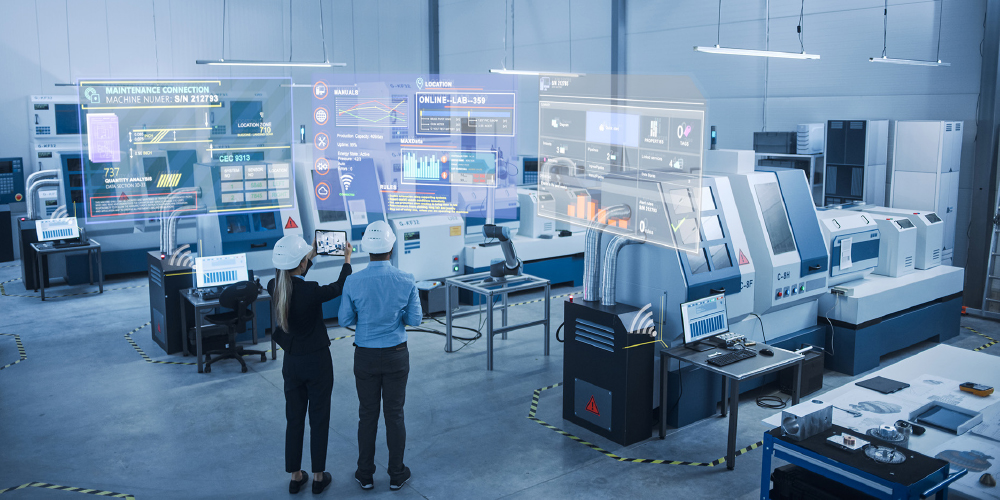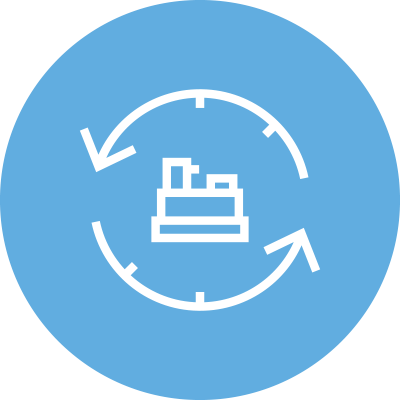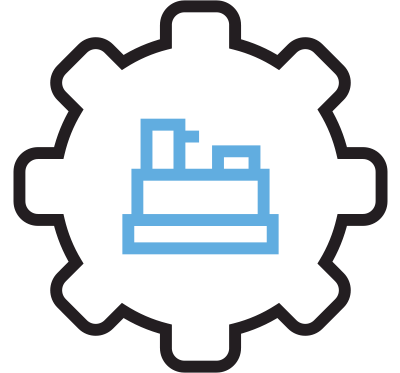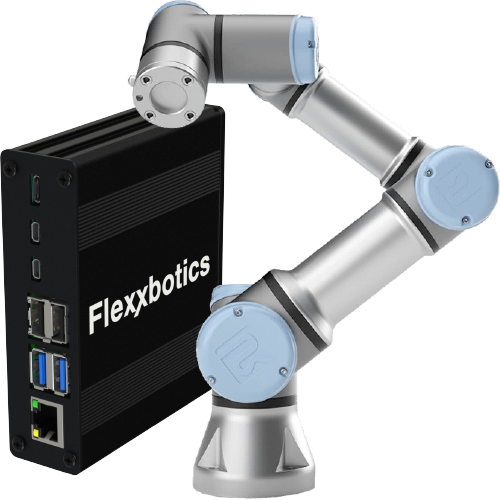
By Flexxbotics: 11/30/2022
What Is OEE & Why Has It Become The
Gold Standard For Manufacturing
Most modern manufacturers use Overall Equipment Effectiveness (OEE) as the gold standard for manufacturing process optimization. OEE is a great metric for many traditional manufacturing applications. However, OEE as the only optimization target in high-mix and dynamic production environments might lead you to less-than-optimal conclusions. By understanding this context and applying alternative KPIs, you can make better decisions to optimize your cobot machine tending operations.
What is Overall Equipment Effectiveness (OEE)?
OEE stands for Overall Equipment Effectiveness. It is a calculation that determines how optimized a manufacturing process is based on a few key metrics. These metrics are used to compare the current performance of the process to how it should perform at its highest potential. Through this analysis, manufacturers can find specific areas of improvement. OEE is broadly considered to be best practice in the manufacturing industry.
Key Metrics of OEE:
Manufacturers calculate OEE using three key metrics: Availability, Performance, and Quality

Availability
Availability is the percentage of time that the machine operates. Availability is more colloquially known as “uptime.” The overall uptime is compared to the downtime to give manufacturers an idea of how often the machine is actually in operation.

Performance
Performance accounts for the speed of the process. The performance metric includes the ideal cycle time and total cycles and compares this value to the total running time of the machine. This metric gives manufacturers insight into whether their machine is reaching its speed potential.

Quality
Quality measures the percentage of acceptable units as a percentage of all units produced. Since some units will be defective, the quality metric quantifies the ability of the production process to create usable parts.
OEE Calculation
Manufacturers can calculate OEE by first calculating availability, performance, and quality. Then, by multiplying these values together, you’re left with a percentage that theoretically defines the effectiveness of your current workflow.
The Overall Equipment Effectiveness Formula:
Availability =
Run Time
Planned Production Time
Performance =
Ideal Run Time x # of Cycles
Run Time
Quality =
Ttl Parts Produced – Defective Parts
Ttl Parts Produced
OEE = Availability X Performance X Quality
Most modern manufacturers use Overall Equipment Effectiveness (OEE) as the gold standard for manufacturing process optimization. OEE is a great metric for many traditional manufacturing applications. However, OEE as the only optimization target in high-mix and dynamic production environments might lead you to less-than-optimal conclusions. By understanding this context and applying alternative KPIs, you can make better decisions to optimize your cobot machine tending operations.
Why is OEE the Gold Standard for Manufacturing?
OEE is considered the gold standard for manufacturing because it can be calculated easily and offers valuable insights. Manufacturers can use these insights to optimize their production processes. Ultimately, these improvements lead to leaner, more efficient, and more profitable facilities.
The OEE calculation lends itself well to helping manufacturers hit their manufacturing goals. The metrics that makeup OEE align well with specific KPIs. For example, identifying quality issues aids in waste reduction efforts. Additionally, for manufacturers aiming to increase throughput, investigating factors affecting availability and performance are good places to start.
These areas of improvement are categorized as the “Six Big Losses.” By identifying factors leading to losses in these categories, manufacturers can take appropriate action to improve.
Availability
Planned Downtime
Breakdowns/Unexpected stops
Performance
Minor stops
Speed loss
Quality
Production reject
Rejects on start up
Most modern manufacturers use Overall Equipment Effectiveness (OEE) as the gold standard for manufacturing process optimization. OEE is a great metric for many traditional manufacturing applications. However, OEE as the only optimization target in high-mix and dynamic production environments might lead you to less-than-optimal conclusions. By understanding this context and applying alternative KPIs, you can make better decisions to optimize your cobot machine tending operations.
Why OEE isn’t Enough for All Circumstances
Unfortunately, OEE is not a silver bullet to improve all manufacturing processes. While it’s an excellent benchmark for most manufacturers, OEE doesn’t take specific context into account. This context is critical when making decisions on workflow changes. Blindly adhering to OEE can be detrimental to the optimization of your process. Let’s cover a few examples where OEE doesn’t capture the entire picture.
Cost:
You might’ve noticed that there’s no cost component to OEE. This calculation is purely looking at hard efficiency and production metrics. However, manufacturing is a business. Overlooking the impact of costs can lead to optimizations that negatively impact your bottom line. For example, it might be more expensive to run production at specific times or in certain circumstances. Optimizing purely for OEE here could mean running production at a higher expense. Furthermore, some parameters might be more costly than others. As an example, imagine you have two options available to you:
1. Improving performance by 10%
2. Improving quality by 15%
These would both significantly positively impact OEE. All else equal, improving quality seems like the better choice. However, this doesn’t take cost into account. Let’s assume the performance improvement costs $20,000, but the quality improvement costs $100,000. Considering the business component, it might make more sense to opt for performance improvements in this example.
Dependencies:
Some parameters might have dependencies on each other. OEE tends to imply its components exist in isolation from one another. In reality, changes to one part of the system can affect others. Consequently, changes aimed at improving one component of OEE impact other components. These effects can be both positive and negative. It’s important to take the entire effects of the system into account.
Dynamic Environments:
OEE doesn’t adapt well to dynamic production environments. Manufacturers commonly deploy cobots into these environments thanks to their adaptability. Examples include high-mix production environments with high cycle time variability, run time, batch size, etc. It’s not usually reasonable to recalculate OEE every time there’s a production change. Small production runs might also be active for a few days. This doesn’t provide much time for optimization.
Furthermore, your metrics will be skewed when measuring current production runs against OEE calculations against production runs on other parts. For example, cycle times for batch A might be 3 mins, but 5 mins for batch B. If you originally calculated OEE against the machine running batch A, comparing the performance of batch B based on that benchmark will yield very poor results. Even huge improvements to batch B’s performance will still lead to terrible OEE results from this perspective.
Other KPIs to Consider
It’s important to have other KPIs in mind when using cobots. Relying on OEE typically isn’t enough for cobot applications. Instead of optimizing for specific values in the OEE formula, manufacturers should aim for profitable, productive, and lean production. Let’s look at a few examples.

Improvements in Cycle Time:
Robots can significantly impact cycle times. Measuring cycle time improvements is an important KPI for cobot automation. The jump from manual to automated processes typically sees great improvements in cycle time. Additionally, automated systems have much more predictable cycle times when compared to manual production. However, manufacturers can measure cycle time improvements to previously automated systems by implementing process improvements.
Ways to improve cycle time include:
– Reducing common faults
– Optimizing for reduced wait time
– Tuning out motion inefficiencies

Improvements in Total Cycles:
Total cycles completed are analogous to overall throughput. A huge benefit of cobots is that they enable manufacturers to run more cycles per day in most circumstances. For example, cobots can continue running as long as material is available. The positive impact on total cycles is a critical KPI to measure the effectiveness of your cobot system.
Ways to improve total cycles include:
– Increasing cycle time
– Reducing downtime
– Reducing changeover/switch time

Improvements in Machine Utilization:
Machine utilization is important for all machines in a manufacturing facility. Certainly, you can measure machine utilization from the perspective of the machine’s utilization. However, it’s equally important to consider the cobot’s utilization. Cobots have a special strength in being especially flexible in the tasks they can handle. For this reason, it’s even more important to monitor the utilization of your cobot. For example, a cobot’s primary task might be machine tending. However, if there are no more parts to run for the time being, a cobot could be switched to other tasks such as packaging or polishing. This increases the cobot utilization rate. A high utilization rate ensures that you’re getting the most out of your investment.
Ways to improve machine utilization include:
– Reducing downtime
– Reassigning your cobot to secondary tasks
How to Record Data for Robot KPIs
Manufacturers have many tools available to them to measure machine performance to calculate OEE and alternative KPIs. The source of these measurements lies in the data collection. Data collection can occur in one of two ways: automated or manual.
Automated data collection systems allow for real-time tracking of machine performance across dozens of metrics. Automated data tracking offers the richest source of data collection for analysis. Automated data collection tools tend to allow for easy pairing with data analysis software. Automated tools can be either first-party or third-party software products.
Manual data collection refers to people explicitly taking measurements in-person. There are many drawbacks to this system including measurement error, observer bias, and low measurement resolution. While automated data collection systems are preferable, manual solutions are better than nothing.
Today’s data-driven manufacturers are making constant improvements and finding competitive advantages. These leading manufacturers understand that high-end cobot operations go beyond OEE. By applying context and considering alternative KPIs, these companies are making the best decision for creating a lean, profitable, and high-performing production environment.
The FlexxConnect UR™ is a great choice for manufacturers moving towards a data-informed approach to continuous improvement. The FlexxConnect UR gives operators real-time feedback on what’s happening with their Universal Robots. For deeper analytics, more detailed information is available to look for areas to optimize. FlexxConnect UR is friendly, simplified, and easy to use. Designed for manufacturers, it puts your Universal Robots data into context and shows you the most important information.

Reach out to us today to schedule your demo!
